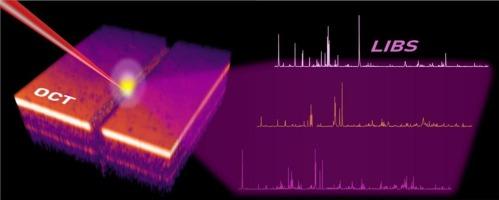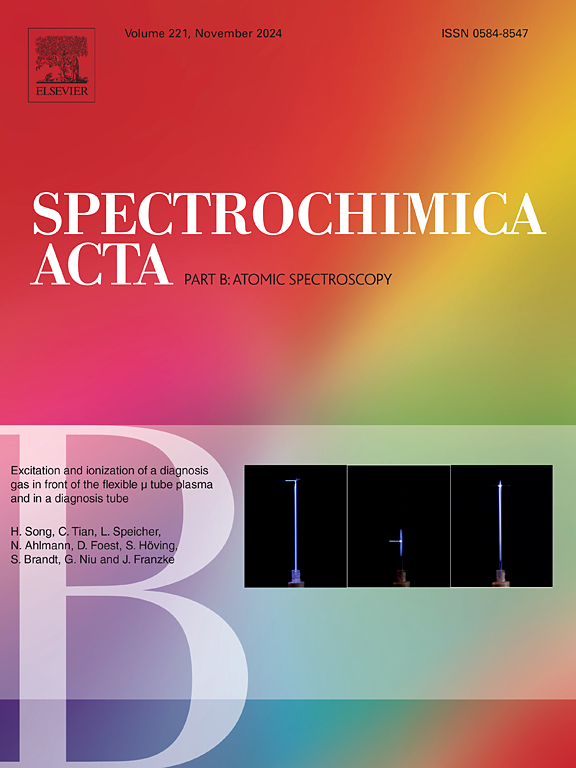比较飞秒脉冲和连续波激光清洗船舶涂层的LIBS
IF 3.8
2区 化学
Q1 SPECTROSCOPY
引用次数: 0
摘要
利用激光诱导击穿光谱(LIBS)研究了船舶防护涂层的激光去除过程。高脉冲重复率飞秒激光系统首先在受控的实验室环境中研究了不同涂层样品和激光参数对LIBS信号的影响。通过系统地改变这些参数并在样品上重复扫描激光束,根据其光谱特征识别出不同的涂层。此外,还分析了烧蚀过程,以跟踪去除每层涂层所需的总烧蚀时间。然后将fs激光系统获得的LIBS光谱与设计用于工业涂层去除的高功率连续波激光系统的LIBS光谱进行比较。对比突出了两个系统在等离子体形成、光谱特性和信号质量方面的关键差异。这些发现增强了对激光参数如何影响涂层烧蚀过程中等离子体产生和发射光谱的理解,为优化基于libs的元素分析提供了见解,从而改善了工业应用中的过程监控和选择性涂层去除。本文章由计算机程序翻译,如有差异,请以英文原文为准。

Comparing LIBS of marine coatings using femtosecond pulses and continuous wave laser cleaning
This study investigates the laser removal process of marine protective coatings using laser-induced breakdown spectroscopy (LIBS). A high pulse repetition rate femtosecond laser system is first employed in a controlled laboratory setting to examine how different coating samples and laser parameters influence the LIBS signal. By systematically varying these parameters and repeatedly scanning the laser beam in a line across the samples, distinct coating layers are identified based on their spectral signatures. Additionally, the ablation process is analyzed to track the total ablation time required to remove each coating layer. The LIBS spectra obtained from the fs laser system are then compared with those from a high-power continuous wave laser system designed for industrial coating removal. The comparison highlights key differences in plasma formation, spectral characteristics, and signal quality between the two systems. These findings enhance the understanding of how laser parameters influence plasma generation and emission spectra during coating ablation, providing insights that could optimize LIBS-based elemental analysis for improved process monitoring and selective coating removal in industrial applications.
求助全文
通过发布文献求助,成功后即可免费获取论文全文。
去求助
来源期刊
CiteScore
6.10
自引率
12.10%
发文量
173
审稿时长
81 days
期刊介绍:
Spectrochimica Acta Part B: Atomic Spectroscopy, is intended for the rapid publication of both original work and reviews in the following fields:
Atomic Emission (AES), Atomic Absorption (AAS) and Atomic Fluorescence (AFS) spectroscopy;
Mass Spectrometry (MS) for inorganic analysis covering Spark Source (SS-MS), Inductively Coupled Plasma (ICP-MS), Glow Discharge (GD-MS), and Secondary Ion Mass Spectrometry (SIMS).
Laser induced atomic spectroscopy for inorganic analysis, including non-linear optical laser spectroscopy, covering Laser Enhanced Ionization (LEI), Laser Induced Fluorescence (LIF), Resonance Ionization Spectroscopy (RIS) and Resonance Ionization Mass Spectrometry (RIMS); Laser Induced Breakdown Spectroscopy (LIBS); Cavity Ringdown Spectroscopy (CRDS), Laser Ablation Inductively Coupled Plasma Atomic Emission Spectroscopy (LA-ICP-AES) and Laser Ablation Inductively Coupled Plasma Mass Spectrometry (LA-ICP-MS).
X-ray spectrometry, X-ray Optics and Microanalysis, including X-ray fluorescence spectrometry (XRF) and related techniques, in particular Total-reflection X-ray Fluorescence Spectrometry (TXRF), and Synchrotron Radiation-excited Total reflection XRF (SR-TXRF).
Manuscripts dealing with (i) fundamentals, (ii) methodology development, (iii)instrumentation, and (iv) applications, can be submitted for publication.

 求助内容:
求助内容: 应助结果提醒方式:
应助结果提醒方式:


